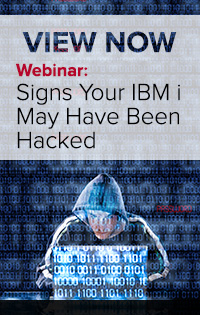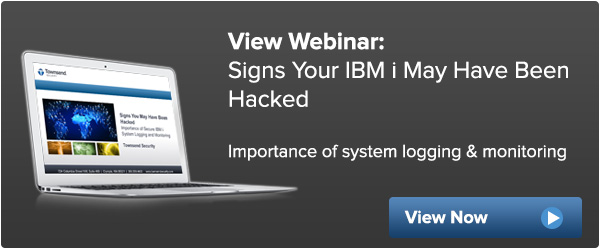(Based on a recent webinar with Townsend Security and Dave Nelson, President of Integrity)
Your IBM i may have been hacked and you don’t even know it yet!
Industry experts from Townsend Security and Integrity discuss how the combination of secure system logging on the IBM i and log monitoring with a SIEM will help you secure sensitive data and minimize the impact of security breaches.
 Topics cover (and go beyond) how log files and log data are the digital evidence (artifacts) that actually take us to a point of action within a system. They look at what the false alarms are within the plethora of data and how to screen those out. Then they also talk about the next steps: What are the red flags to watch for, and what to do with those red flags.
Topics cover (and go beyond) how log files and log data are the digital evidence (artifacts) that actually take us to a point of action within a system. They look at what the false alarms are within the plethora of data and how to screen those out. Then they also talk about the next steps: What are the red flags to watch for, and what to do with those red flags.
“As we look at the millions of data points that are created each day, every login or logout, every time a user is created, every time a user accesses a resource or adds a new resource or saves a file…. amidst all that data, hacking events happen. What we have to try and do is understand the ways that we can sift through that data and reduce the background noise and address the successful attacks.” (Dave Nelson)
Things to look for in log files as we’re trying to identify what’s real data, false alarms, or red flags:
New users and user accounts - Look for things like random names (like BSX or BS4XOR) and be able to identify new users. Always be able to trace these new user accounts back to a user account request and be able to identify which of those accounts have an approved resource and which ones have not.
New files and directories - Identify new directories, look for batches of files that show up between things that are normally next to each other. One of the things hackers love to do is hide files on any sort of Windows mountable or UNIX mountable directories within your i Series because a lot of times the IBM i doesn’t have an antivirus check or an antivirus application on it.
Date and time stamps - There are some (system) files that you know shouldn’t change. If you start to notice that those file modification dates or the save dates on those files and libraries have changed, that should start to be a red flag.
Significant increase or decrease in the size of a file or a library - Hackers will inject data into the back end of an existing file so that the file itself doesn’t change and it can still be executed. So watch for files that used to be a few kilobytes and are now a few megabytes or even gigabytes.
New processes or services that are running - Anytime you have a batch job that’s running and you’re not familiar with it, that should be something that you look at right away. Look for unusual interactive jobs working between LPAR’s or between systems. Do you normally have data leaving your IBM i and going to another platform? or a direct connection from a Windows server directly into your IBM i?
Cryptic or unusual file names - Create some sort of naming convention within your organization so that you know if something is outside of that standard.
It is suggested that we think of log files as the forensic evidence for the IBM i system and think about monitoring almost as a crime scene investigation. The relationship between the logging agent and the collector of those logs is very important because unexplained system value configuration changes, application changes, changes to privileges and privileged user profiles are indicators of potential malicious activity that you can record. These logging tools are strengths for an organization to really get to know what the system is doing as part of daily business activity, and then how to alert and monitor for data protection.
With all the different types of data that you can look for, the sheer volume of information that’s out there, there’s absolutely no way that an individual system administrator and application developer, even a full time security professional is going to be able to sift through that amount of information. Partnerships between the SIEM (Security Information and Event Management) collector and the logging agent are now industry standard defense and depth controls. Automation and email notifications about potential malicious activity can immediately give you the chain of custody to provide the digital evidence you require to go investigate further. You want to be able to drill down to specific threats, events, and user specific events as part of any good governance risk & compliance program and risk management approach. Essential for a total enterprise solution is the partnership (and strong encryption) between LogAgent and a SIEM.
As a SIEM solution that partners with Townsend Security’s logging solution*, what Integrity’s done differently is provide a managed SIEM service. Dave tells us “We’ve got clients running this on the i Series platform using Alliance LogAgent to monitor, interfacing with our SIEM, and they have said ‘Wow, we didn’t have any idea that we could get this much information and that it could be this easy to access and that we can share it’. Clients want to be able to share that with their network administrators and say ‘See, this is what we’re seeing, we’re seeing this traffic and we don’t know why it’s coming in, can you please stop it and block it’. One of the best things about Integrity’s SIEM solution from a cost perspective is that there’s no capital investment. You don’t have to spend $100,000 for the software, $50,000 for hardware and then go out and hire a full time person to review these logs and to set up the system and manage another system and application within the environment. It’s all provided for you for a low monthly cost. You get this in a matter of days and weeks instead of a matter of months. So you’re getting immediate return on your investment. In these economic times we all know how important that is to be able to show ‘Hey, we’re getting some real value for this expenditure that we’re making, we’re seeing a lot of things happening’. One of the other benefits is that you’re not going to see just security information from this. The amount of information that you’re going to get, you’re going to see operational things that you hadn’t seen in the past. You’re going to see things that you look at and say ‘Wow, we had no idea the system was operating that way, or those processes were running, or those jobs were running or taking so long to run’. The feedback that we get from our clients is that the value they get from the operational side of the SIEM is almost, if not as much, as what they get from the security side of the SIEM. So just being able to see deeper into the environment and seeing what’s happening, what’s going on has been great for a lot of our clients as well.”
*Townsend Security’s Alliance LogAgent is a comprehensive platform specific solution for IBM i which helps cut through the noise and deliver granular valuable data, providing file integrity monitoring right down to field level changes. Key steps you want and need for compliance purposes as well as data security.
For a much deeper and more detailed discussion on secure system logging and monitoring as essential controls to detect and mitigate the risk of a data breach, please request a download of the entire webinar:

